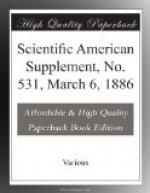Referring to the estimates given in Table I., I may explain that the item of repairs and renewals covers 10 per cent. on boilers and gas producers, 5 per cent. on engines, 5 per cent. on buildings, and 5 per cent. on mains. Considering that the estimates include ample fitting shops, with the best and most suitable tools, and that the wages list includes a staff of men whose chief work would be to attend to repairs, etc., I think the above allowances ample. Each item also includes 5 per cent. for contingencies.
I have commenced by giving all the preceding detail, in order to show the groundwork on which I base the estimate of the cost of compressed air power to consumers, in terms of indicated horse power per annum, as given in Table II. I may say that, in estimating the engine power and coal consumption, I have not, as in the original report, made purely theoretical calculations, but have taken diagrams from engines in actual use (although of somewhat smaller size than those intended to be employed), and have worked out the results therefrom. It will, I hope, be seen that, with all the safeguards we have provided, we may fairly reckon upon having for sale the stated quantity of air produced by means of the plant, as estimated, and at the specified annual cost; and that therefore the statement of cost per indicated horse power per annum may be fairly relied upon. Thus the cost of compressed air to the consumer, based upon an average charge of 5d. per 1,000 cubic feet, will vary from L6 14s. per indicated horse power per annum to L18 13s. 3d., according to circumstances and mode of application.
A compressed air motor is an exceedingly simple machine—much simpler than an ordinary steam engine. But the air may also be used in an ordinary steam engine; and in this case it can be much simplified in many details. Very little packing is needed, as there is no nuisance from gland leakage; the friction is therefore very slight. Pistons and glands are packed with soapstone, or other self-lubricating packing; and no oil is required except for bearings, etc. The company will undertake the periodical inspection and overhauling of engines supplied with their power, all which is included in the estimates. The total cost to consumers, with air at an average of 5d. per 1,000 cubic feet, may therefore be fairly taken as follows:
Min.
Max.
Cost of air used L6 14 01/2
L18 13 3
Oil. waste, packing, etc. 1
0 0 1 0 0
Interest, depreciation,
etc., 121/2 per cent.
on
L10, the cost of engine
per indicated
horse power
1 5 0 1 5 0
--------
---------
L8
19 01/2 L20 18 3
The maximum case would apply only to direct acting engines, such as Tangye pumps, air power hammers, etc., where the air is full on till the end of the stroke, and where there is no expansion. The minimum given is at the average rate of 5d. per 1,000 cubic feet; but as there will be rates below this, according to a sliding scale, we may fairly take it that the lowest charge will fall considerably below L6 per indicated horse power per annum.—Journal of Gas Lighting.




